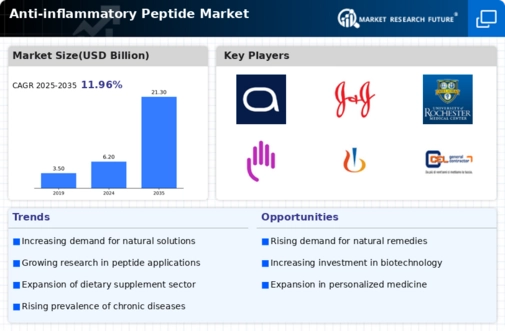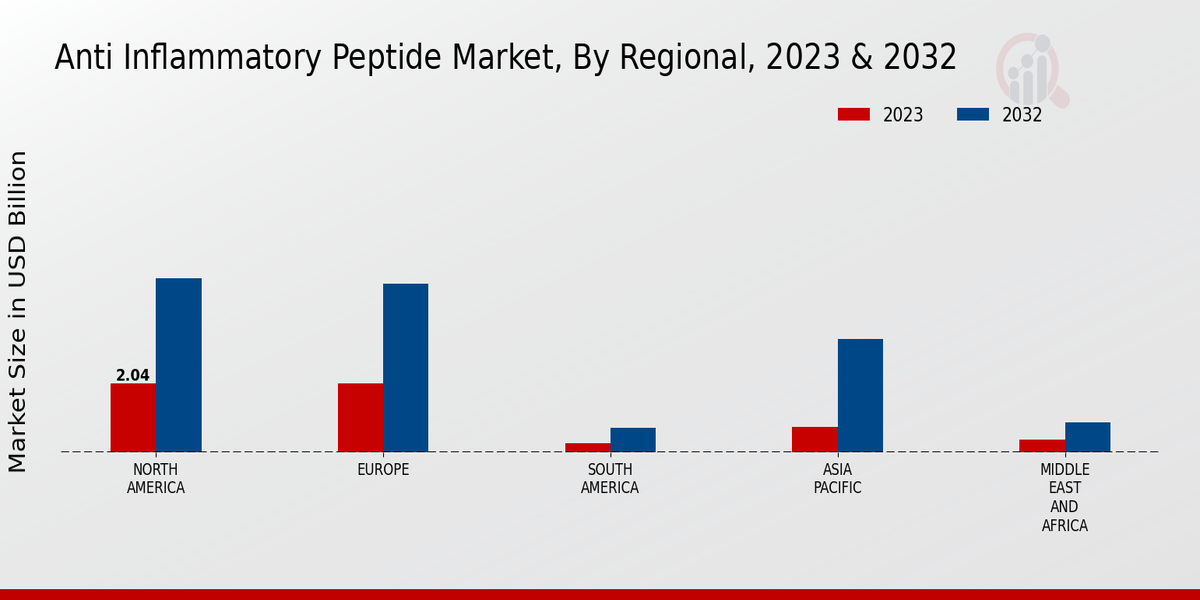Market Growth Projections
The Global Anti-inflammatory Peptide Market Industry is projected to experience substantial growth over the next decade. In 2024, the market is expected to reach 6.2 USD Billion, with forecasts indicating a rise to 21.3 USD Billion by 2035. This growth trajectory suggests a compound annual growth rate (CAGR) of 11.89% from 2025 to 2035, reflecting increasing investments in research and development, rising consumer demand for health products, and advancements in peptide technology. Such projections underscore the potential for anti-inflammatory peptides to play a pivotal role in future healthcare solutions.
Advancements in Biotechnology
Technological advancements in biotechnology are significantly influencing the Global Anti-inflammatory Peptide Market Industry. Innovations in peptide synthesis and purification techniques have enhanced the efficiency and efficacy of anti-inflammatory peptides. These advancements enable the development of novel therapeutic agents that can target specific inflammatory pathways, potentially leading to more effective treatments with fewer side effects. As a result, the market is expected to grow substantially, with projections indicating a rise to 21.3 USD Billion by 2035. This growth underscores the importance of continued investment in biotechnological research and development to harness the full potential of anti-inflammatory peptides.
Increasing Consumer Awareness
Consumer awareness regarding the benefits of anti-inflammatory peptides is on the rise, contributing to the expansion of the Global Anti-inflammatory Peptide Market Industry. As individuals become more informed about the health implications of inflammation and the potential of peptides as natural remedies, there is a growing demand for products that incorporate these compounds. This trend is particularly evident in dietary supplements and functional foods, where consumers seek out ingredients that promote health and wellness. The market's growth trajectory, with a projected CAGR of 11.89% from 2025 to 2035, indicates that this heightened awareness is likely to drive significant sales in the coming years.
Rising Prevalence of Chronic Diseases
The Global Anti-inflammatory Peptide Market Industry is experiencing growth due to the increasing prevalence of chronic diseases such as arthritis, diabetes, and cardiovascular disorders. These conditions often involve inflammatory responses that can be mitigated by anti-inflammatory peptides. As the global population ages, the incidence of these diseases is likely to rise, driving demand for effective therapeutic options. In 2024, the market is projected to reach 6.2 USD Billion, reflecting a growing recognition of the role of peptides in managing inflammation. This trend suggests a robust future for the industry as healthcare systems seek innovative solutions to address chronic health challenges.
Regulatory Support for Peptide Therapies
Regulatory bodies are increasingly recognizing the therapeutic potential of anti-inflammatory peptides, which is positively impacting the Global Anti-inflammatory Peptide Market Industry. Supportive regulatory frameworks facilitate the approval process for peptide-based therapies, encouraging pharmaceutical companies to invest in research and development. This regulatory backing not only enhances the credibility of peptide therapies but also fosters innovation within the industry. As a result, the market is poised for growth, with expectations of reaching 21.3 USD Billion by 2035. This trend highlights the importance of collaboration between regulatory agencies and industry stakeholders to advance peptide-based solutions.
Emerging Applications in Sports Nutrition
The Global Anti-inflammatory Peptide Market Industry is witnessing emerging applications in sports nutrition, as athletes and fitness enthusiasts increasingly seek products that aid recovery and reduce inflammation. Anti-inflammatory peptides are being incorporated into supplements designed to enhance performance and support muscle recovery post-exercise. This trend is driven by a growing understanding of the role of inflammation in athletic performance and recovery. As the market evolves, it is anticipated that the demand for such products will contribute to the overall growth of the industry, with projections indicating a CAGR of 11.89% for 2025 to 2035.






















